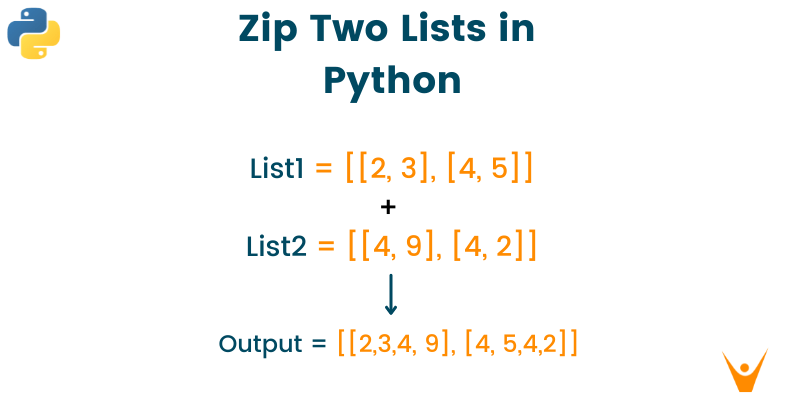There are numerous occasions in Python where a link between two or more iterators is required, such as tuples, dictionaries, lists, and sets. Zipping is the python term for pairing such iterators. In this article, how python zip two lists together.
Lists in python are just like dynamically sized arrays, declared in other languages (vector in C++ and ArrayList in Java). Lists need not always be homogeneous, which makes it the most powerful tool in Python. To learn more about python lists, visit our article "3 Ways to Find Python List Size".
Using a normal zip function, you can easily aggregate the contents of the container class. There are times, though, when numerous lists and contained lists are required as index components, and you must merge them. This is an odd circumstance, but the solution is straightforward. So, let's see how things work!
How to Zip Two Lists in Python?
Below are the three methods by which python zip two lists:
1) Using the built-in zip() function
Python possesses an extensive collection of in-built methods, one of which is the zip() function. Using the zip() function, you can create an iterator object containing tuples (know more about tuple at "3 Ways to Convert Lists to Tuple in Python"). It can be helpful to think of the zip() function as combining two or more lists (or other iterable objects) into an object containing ordered tuples from the lists. The below example shows how the zip() function can easily merge two lists in python without any extra effort.
For example:
list_a = [1, 3, 4] list_b = [5, 7, 11] list_zip = zip(list_a, list_b) zipped_list = list(list_zip) print(zipped_list)
Output:
[(1, 5), (3, 7), (4, 11)]
2) Using map() + __add__
map() function is another in-built python method similar to zip() function above. It enables you to zip the elements of the iterable by mapping the elements of the first iterable with the elements of the second iterable. By using the map() function along with the addition operator, you can merge two lists in python as shown in the below example:
list_1 = [[2, 3], [4, 5], [7, 6]] list_2 = [[4, 9], [4, 2], [11, 10]] print ("The given list 1 is : " + str(list_1)) print ("The given list 2 is : " + str(list_2)) res = list(map(list.__add__, list_1, list_2)) print ("The zipped list is : " + str(res))
Output:
The given list 1 is : [[2, 3], [4, 5], [7, 6]] The given list 2 is : [[4, 9], [4, 2], [11, 10]] The zipped list is : [[2, 3, 4, 9], [4, 5, 4, 2], [7, 6, 11, 10]]
3) Using 'for' loop with zip() function
You can also zip two lists in python with the combination of zip() function and for loop. It is the least used method where the interlist aggregation can be done with the chain function, while the intralist aggregation can be done with the zip() function. Here, you have to make use of chain() function which is part of python itertools library and therefore, the library is imported using "import" keyword before beginning the source code. Check out the below example for better understanding of this method.
For example:
import itertools list_1 = [[1, 3], [4, 5], [5, 6]] list_2 = [[11, 9], [16, 2], [4, 10]] print ("The given list 1 is : " + str(list_1)) print ("The given list 2 is : " + str(list_2)) res = [list(itertools.chain(*i)) for i in zip(list_1, list_2)] print ("The zipped list is : " + str(res))
Output:
The given list 1 is : [[1, 3], [4, 5], [5, 6]] The given list 2 is : [[11, 9], [16, 2], [4, 10]] The zipped list is : [[1, 3, 11, 9], [4, 5, 16, 2], [5, 6, 4, 10]]
Summary
To summarize, lists are the most used data structure in python language and hence face the difficult situation to zip the elements while programming. In this article, we studied various methods to zip the elements of two lists and you can use any of them according to the different situations you face while coding the program. However, the zip() function is highly used and the most recommended method to zip the lists faster and efficiently.








